As the U.S. emerges as the world’s top natural gas supplier due to the shale renaissance and Europe’s decision to turn to the west, American natural gas companies such as Comstock Resources (CRK) are set to win big. However, credit rating agencies give Comstock a B+ rating, despite its increasing earnings and current position in the energy industry. Today’s FA Alpha Daily will examine the company’s true credit risk.
FA Alpha Daily:
Wednesday Credit
Powered by Valens Research
Off the back of the Russian invasion of Ukraine, supply chains are disrupted and geopolitical embargos have reentered the global economy in force.
Despite investment into alternative power sources such as wind and solar, natural gas remains one of the most demanded energy sources.
According to BP’s Statistical Review of World Energy 2022, global natural gas consumption has been on a rising trend since 1965…and continues to rise.
The shale renaissance has had a substantial impact on the supply capabilities of the U.S., now the world’s largest producer. The country’s natural gas output will rise to a record high in 2022.
Also, the demand is higher than it has been before. With the European Union and other countries refusing to import natural gas from Russia, they are turning to the west.
Booming demand for natural gas means cash flow machines for U.S. natural gas companies. One company that stands out as a big potential winner is Comstock Resources (CRK).
The company engages in the acquisition, exploration, and production of oil and gas in the United States.
The energy player consistently increased its earnings since 2016 and its oil and gas reserves reached 6.1 trillion cubic feet of natural gas equivalent as of December 2021.
And yet, credit agencies fail to understand the value of the industry and the company.
S&P rates a company at the center of the shale renaissance like Comstock a B+, which implies a 25% chance of default.
Given the company’s success in increasing earnings and its current position in the energy industry, this rating seems wildly unrealistic.
We can figure out if there is a real risk for this company by leveraging the Credit Cash Flow Prime (CCFP) to understand the company’s obligations matched against its cash and cash flows.
In the chart below, the stacked bars represent the firm’s obligations each year for the next five years. These obligations are then compared to the firm’s cash flow (blue line) as well as the cash on hand available at the beginning of each period (blue dots) and available cash and undrawn revolver (blue triangles).
The chart proves that Comstock Resources has a much safer credit profile than the credit agencies suggested. The CCFP shows that the company’s cash flows consistently exceed operating and financial obligations for the next 6 years.


The company will have no issues with its investments and even can take on more debt if necessary.
As a result, Comstock Resources gets an IG3 rating from Valens. This corresponds to a default risk which is less than 2%, which makes much more sense when we can see the company’s balance sheet in context.
It is our goal to bring forward the real creditworthiness of companies, built on the back of better Uniform Accounting.
To see Credit Cash Flow Prime ratings for thousands of companies, click here to learn more about the various subscription options now available for the full Valens Database.
SUMMARY and Comstock Resources Tearsheet
As the Uniform Accounting tearsheet for Comstock Resources, Inc. (CRK:USA) highlights, the Uniform P/E trades at 6.3x, which is below the global corporate average of 19.3x and its historical P/E of 9.4x.
Low P/Es require low EPS growth to sustain them. In the case of Comstock, the company has recently shown an 875% Uniform EPS growth.
Wall Street analysts provide stock and valuation recommendations that in general provide very poor guidance or insight. However, Wall Street analysts’ near-term earnings forecasts tend to have relevant information.
We take Wall Street forecasts for GAAP earnings and convert them to Uniform earnings forecasts. When we do this, Comstock’s Wall Street analyst-driven forecast is for an 85% and 71% EPS growth in 2022 and 2023, respectively.
Based on the current stock market valuations, we can use earnings growth valuation metrics to back into the required growth rate to justify Comstock’s $17 stock price. These are often referred to as market embedded expectations.
The company is currently being valued as if Uniform earnings were to shrink by 14% annually over the next three years. What Wall Street analysts expect for Comstock’s earnings growth is above what the current stock market valuation requires in 2022 and 2023.
Furthermore, the company’s earning power in 2021 is 3x the long-run corporate average. Also, cash flows and cash on hand are more than 2x its total obligations—including debt maturities and capex maintenance. However, the company has an intrinsic credit risk that is 380bps above the risk-free rate.
Overall, this signals a moderate credit and dividend risk.
Lastly, Comstock’s Uniform earnings growth is well above its peer averages, and the company is trading in line with its average peer valuations.
Best regards,
Joel Litman & Rob Spivey
Chief Investment Strategist &
Director of Research
at Valens Research
This analysis of Comstock Resources (CRK) credit outlook is the same type of analysis that powers our macro research detailed in the member-exclusive FA Alpha Pulse.
